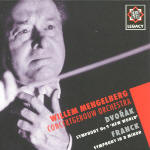There’s not much that need trouble us concerning these two performances, other than the fact that they are thoroughly mediocre in completely different ways. The Franck Symphony features all of those famous “Mengelbergisms”: tempos pulled about like taffy; soupy string portamentos everywhere (listen to the transition to the first movement’s second subject) that serve only to reinforce the opinion of those who view this work as the acme of vulgar sentimentality; and a general lack of structural cohesion evidenced by erratically chosen tempos (the slow introduction comes back much faster the second time around, and doesn’t relate logically to the ensuing allegro). The playing, as such, is pretty good, though hardly great, and all the slurping and sliding in the world won’t cover the basic thinness of violin tone. If you like this sort of approach, Stokowski beats Mengelberg at his own game, with a Dutch orchestra no less (Hilversum Radio), in luscious stereo sound on Cala. You get a raft of similar gearshifts alongside strings that play with all the sensuality Mengelberg lacks. Or for a more normal approach with plenty of rhetorical emphasis nonetheless, there’s Bernstein’s terrific DG recording. Monteux’s benchmark Chicago version for RCA is, of course, in a class of its own.
Mengelberg treats Dvorák more respectfully than he does Franck, though with even less compelling results thanks to some pretty awful playing and conducting. Note the muffled timpani at the end of the first movement introduction, the insensitively rushed second subject, the dreadful trumpet solo at the beginning of the development, and wobbly horns at the return of the principal theme in the recapitulation. The slow movement features a nice English horn solo: “seldom…played with such color and warmth,” according to James North’s notes. Bull. I can think of about two dozen performances where it’s played just as well, if not better. And what about the gruff-toned brass chorales, or the atrocious balances at the movement’s climax (is the oboe stationed in Denmark)? The scherzo suffers from a lack of rhythmic impetus, partly a result of Mengelberg’s fussy articulation of the main theme and slightly slow basic tempo, and partly from the lack of dynamism in the playing (for example, the non-crescendo in timpani and strings leading to the fortissimo statement of the opening tune). As for the finale, it more or less moves along on auto pilot, save for a mangled horn call before its big climax–a singularly weak and unimpressive moment when it finally arrives thanks to Russian-sounding (in the bad sense) brass and a near total absence of bass underpinning. Once again, any number of modern renditions leaves Mengelberg & Co. in the musical dust: with this orchestra alone, there’s Dorati (Philips), Davis (Philips), and Harnoncourt (Teldec), and most exciting of all, Bernstein’s New York thrill fest for Sony.
Sonically, these recordings have almost no dynamic range. Play the opening of the Franck’s first movement then skip to the finale: no difference (if anything, it’s the finale that’s at an even lower level). The effect is comparable to listening over a small transistor radio, which is of course what so many people like about historical orchestral recordings. Their flat perspectives and limited range prevent much other than the surface tunes and basic tempos from reaching the ear with anything remotely resembling sonic realism, so they are in some ways “easier” to take than good modern stereo, especially if you listen on lousy equipment to begin with. There’s no point getting into the transfer game: Bryan Crimp knows his job, and if these were performances of a significance comparable to say, Schnabel’s Beethoven sonatas, where you really can notice sometimes meaningful differences in tone and touch depending on which transfer you get, that would be one thing. Mengelberg’s recordings, for the most part, have no such value. They remain interesting only in a generically historical sense: that is, to the extent every performance of anything is different from every other performance of the same work. Musically, though, there’s nothing special here, and if you simply must know what was doing in these two symphonies circa 1940, then get Munch’s 1945 Paris Conservatoire Franck (Decca Japan), and Szell’s 1937 Czech Philharmonic Dvorák (Dutton).
































